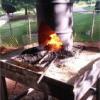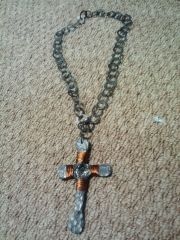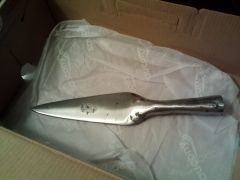-
Posts
1,590 -
Joined
-
Last visited
Content Type
Profiles
Forums
Articles
Gallery
Downloads
Events
Everything posted by Nobody Special
-
Bring a friend. Bring beer. Have friends bring beer. Don't drink said beer until said anvil is completely in place and stable. Failing that, use a cherry picker. and chains. Stabilize COMPLETELY, using bolts clamps, whatever before moving. Don't take a chance of having something the weight of an engine block slip and hurt you.
-
It's not the prettiest, but it's cool, well crafted, and I would be proud to own it, or have made it. If you change the handle, more of the red burl might be nice. The grain of the blade is nicely contrasted by the swirls in the wood grain.
-
Interesting. I wonder what kind of results you would get with anthracite heating coal. Or if it would have enough of an updraft to even light well in a wood stove.
-

coal in georgia
Nobody Special replied to Rhettbarnhart's topic in Solid Fuels: Coal, Coke, Charcoal, Wood, etc
Huh? What? Where? You've got my attention. But............ I'm with Vaughn on this one, where are they located? No location or prices on their site. -
Well, think of it like this - if you're Galway, and you play in a world class orchestra, you probably won't be playing on a high school second knockoff of a suzuki or a yamaha instrument. You'll have the lovely gold, handtooled, custom built flute you require to make world class music. But if you want muck about and learn about making good music, the 100 dollar starter flute with leaky pads and a couple of bad springs that you got at the pawn shop'll probably serve ya just fine for a few years. If you want more of a hearth for a brake drum (and I like the shallower brake discs better), add something for a shell, and a little refractory or fireclay - an old grill, a lawnmower flipped over, or the ever classic 55 that Glenn designed. My first two knives (well, at my level then, more like letter openers) were made in a slit in the ground with a hairdryer blowing through a steel pipe over heating coal. I think my cost on the lawnmower forge I'm using now was about twenty bucks for pipe fittings, ten for a blower, (old hairdryer and rheostat), and about five or six bucks for the homemade refractory ingredients. You can always put about 30 bucks a month aside for blacksmithing tools, (like I'm saving for a post vice/better anvil, etc.) and if/when you get tired of the old brake drum, work your way up to a "proper" forge, then maybe even a brick and mortar type. That's about the cost of one good meal with a friend.
-

What is this thing?
Nobody Special replied to Bentiron1946's topic in Tools, ID, and pictorial reference
I THINK it's for planishing sheet metal. Shapes and smooths it. May have very fast hammer depending on type. -

making ali ingots
Nobody Special replied to grimme's topic in Smelting, Melting, Foundry, and Casting
Everything Glenn said, extra emphasis on finding a friend with a LOT of experience. Splashing metal from a mold or failed crucible HURTS. (Not that I'd know..........the scars have mostly faded, right?) That said, used to have good luck with casting ingots in green sand. In an absolute fix, wet play sand works too, to a point, but you end up with more particulate matter in the outside, and the outer surface is much rougher/more porous. You still want to find someone that's done this with green sand, (or play sand) so you learn to do this right, without getting flash burns from steam, metal spattering, etc. You can also (if you have a large enough container with water, preferably metal) pour it in slowly, with all ppe maxed out to make shot or streamers, but they're not regularly shaped. See above cautions. If your casting experience is limited, absolutely do not try without someone who's done it. I really wouldn't try some of the baking tray/muffin tin gimmicks I've seen. There's a number of problems with them, and even if it works, it can be next to impossible to free them from the mold after without wrecking it. Casting is like learning to play clarinet, any idiot with a plan can melt metal, but it takes years of practice and mentorship to become really good at it. -

What to do with Large Wine Jugs?
Nobody Special replied to CaptainBruno's topic in Blacksmithing, General Discussion
Well first ya take water, add honey and raisins, and bring to just below a simmer........... -

A Little Help from you guys that have been around the block
Nobody Special replied to jmccustomknives's topic in Knife Making
Look for it with uii instead of ull. Among other tidbits, it pops up that it's supposed to float, and i think the cap on the back of the handle comes off. Possibly threaded with a nut if that handle is hollow? -

Aluminum from Coinage
Nobody Special replied to Chinobi's topic in Smelting, Melting, Foundry, and Casting
Pennies past 1987 are 98% zinc, however I agree with you about melting it at home. Especially since aluminum melts around 600 degrees or so hotter than zinc. Better safe than in the hospital drinking lots of milk and wondering what happened. (I've melted it from time to time, but then, I'm occaisionally stupid, and got zinc poisoning this way on one occaision when I tried it without proper ventilation.) Thomas, how old ARE you??? -
A lawnmower works just fine with a little refractory and a brake drum. I like a disc a little better though for a firepot. This is mine. Made it a couple of years ago, and I might need to patch the refractory a little in a few months. http://www.iforgeiron.com/gallery/image/36990-cam00122/ http://www.iforgeiron.com/gallery/image/36989-cam00121/
-

Aluminum from Coinage
Nobody Special replied to Chinobi's topic in Smelting, Melting, Foundry, and Casting
Depends on your intent too. If you're planning to cast something small and decorative, you could probably use what you've got. If you're planning to build something like a lathe, or drill press, that depends on strong structural integrity, maybe not with an unknown alloy. I wouldn't necessarily try to get more of the same without knowing. If you're looking for scrap aluminum to cast, I've had good luck with breaking up cast parts from cars, such as aluminum pistons, trannie cases, alternator cases, intake manifolds, etc. Also note that a straight, single casting without heat treating may change the composition and structure of the alloys. -
Very nice, remind her not to water them though....
-

Bronze: potential health issues?
Nobody Special replied to Harris Snyder's topic in Safety discussions
Silicon bronze is fairly safe for most casting/working, and is not hard to order online. A big thing to watch out for is zinc poisoning, which you can get from a lot brass or "bronze" alloys by breathing the fumes when they get hot. There's even what is sometimes called architectural bronze, which is often straight copper and zinc. Zinc poisoning feels very similar to an instant case of flu/pneumonia, and in severe cases can kill you. Not unheard of for people to get it even from welding or brazing. Best to use good ventiliation and take precautions when working with unknown alloys. When in doubt, better safe than sorry. -

Aluminum from Coinage
Nobody Special replied to Chinobi's topic in Smelting, Melting, Foundry, and Casting
One's from the 40s were pure Al, or around .5% Cu. Can't read the date on yours. Later one's don't know specific alloys, but some of the later ones were aluminum bronze alloy, and I noticed yours look yellow, although that may be the light. So readeth the coin collectors sites. -
So, ok, have to read up on metallurgical logistics in post-roman times, sundry-dark ages, northern Renaissance under the tsars, probably the Varangian guard, and find out if in Little Rock/Arkadelphia they've figured out how to order bar stock using this new-fangled television/typewriter device. And then see how it affected the making of maille. :D
-

possible iron ore/slag/bloom
Nobody Special replied to forgenorth's topic in Smelting, Melting, Foundry, and Casting
Roasting doesn't just drive out moisture, it changes the oxidation state. (or so I've read, only ever melted wee little amounts). Dropping hot ore in cold water makes it crack/and or easier to bust up in my experience. More brittle. They'll be more brittle than to begin anyways, even without the quenching. True of most rocks, stuff I ring the firepits where I burn leaves and make charcoal is Basalt and grabbo, with some iron inculusions, and it's all crumbly or cracked from the heat. May vary depending on the ore. -
Amazing. Beautiful
-

possible iron ore/slag/bloom
Nobody Special replied to forgenorth's topic in Smelting, Melting, Foundry, and Casting
IF it's ore, roast it a fire, drop in water, then bust it up. Invite a friend, bring beer. You'll need it, this is incredibly tedious. And you're going to need a LOT of lump charcoal. Lots of variations on furnaces. This site has some interesting info, but check around. http://iron.wlu.edu/ . The info's out there, on the process, but you have to adjust your searches to avoid WoW and Minecraft. Not all ore takes a magnet well. I've got about 120 lbs sitting around my garage in buckets, and if the moon's in the right house, and the wind's blowing right, it's magnetic, a little bit. If you think you've got a bloom, why not cut a little off and take a look at the inside? -
My favorite's the treadle lathe. Great illustrations, but my Latin just plain isn't up to it.
-
Used a large glass bead, like a marble, color went away when it melted. Dunno what they used to color it. May have done better with a bit of green beer bottle glass. Was more in it too, but broke when I dunked it to crack the glass. Next one'll be better.
-
http://www.iforgeiron.com/gallery/image/36996-split-cross/ So, tried my first split cross. I won't tell ya how long it took, but I didn't win any time trials, especially after my blower failed in the middle. I was going to make a celtic cross for St. Patrick's day, and kinda got carried away. Started life as a railroad spike, some solenoid wire and a marble (yes there's hard to see glass in the middle.) Chain is left over links from working about with mail. What do ya think, too cheesy? :)
-
-
-

Well, that was different, triangles
Nobody Special replied to Nobody Special's topic in Blacksmithing, General Discussion
Two weeks? Even without a forge....get a map torch and get busy man!- 5 replies
-
- triangle
- anthracite
-
(and 1 more)
Tagged with:


